Top speed 513 km/h Length 24 m Retired 1963 | Wingspan 37 m Introduced 1945 First flight June 9, 1944 | |
 | ||
Manufacturers | ||
Avro lincoln
The Avro Type 694, better known as the Avro Lincoln, was a British four-engined heavy bomber, which first flew on 9 June 1944. Developed from the Avro Lancaster, the first Lincoln variants were known initially as the Lancaster IV and V but were renamed Lincoln I and II. It was the last piston-engined bomber used by the Royal Air Force.
Contents
- Avro lincoln
- Design and development
- Royal Air Force
- Royal Australian Air Force
- Argentine Air Force
- Use in aero engine research
- Commercial service
- Variants
- Operators
- Argentina
- Australia
- United Kingdom
- Specifications Lincoln I
- References

The Lincoln became operational in August 1945. It had been assigned to units of Tiger Force, a Commonwealth heavy bomber force, intended to take part in the Second World War Allied operations against the Japanese mainland but the war ended before the Lincoln was used in combat. The Lincoln was used in action during the 1950s, by the RAF in the Mau Mau Uprising in Kenya and with the RAF and RAAF during the Malayan Emergency.
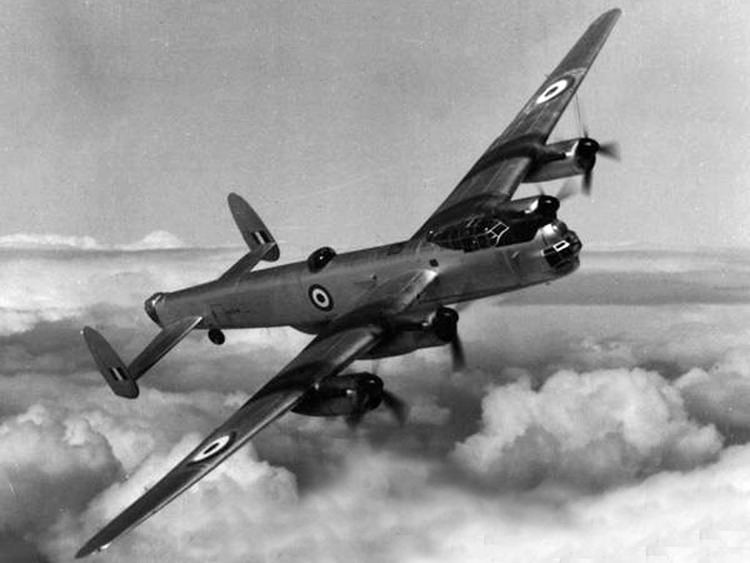
The type also saw significant service with the Royal Australian Air Force (RAAF) and the Argentine Air Force (Spanish: Fuerza Aérea Argentina), as well as some civil aviation use.
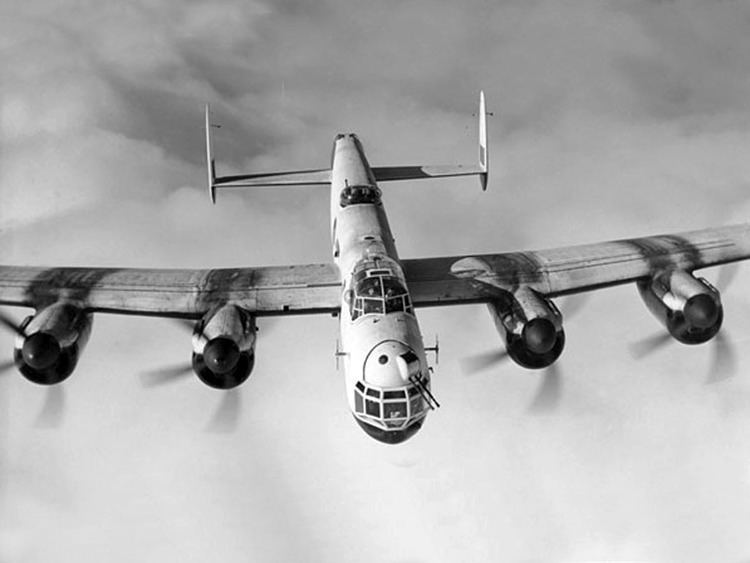
In RAF service, the Lincoln was replaced by jet bombers, chiefly the English Electric Canberra, as well as the three strategic bombers of Britain's V Force – the Vickers Valiant, Handley Page Victor and the Avro Vulcan. In Argentine service it was also replaced by the Canberra.
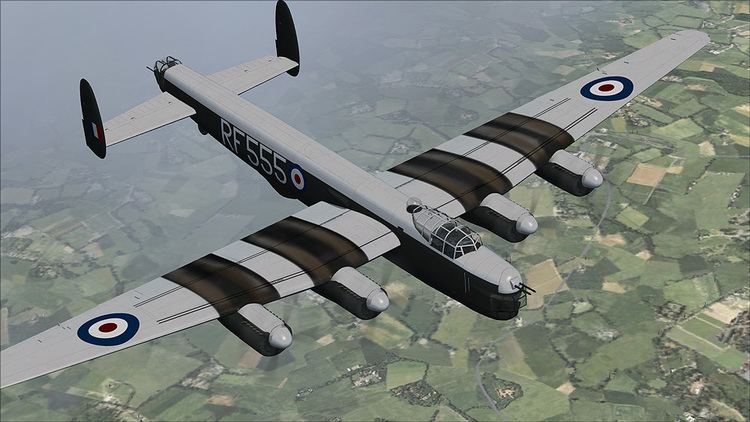
Avro lincoln
Design and development
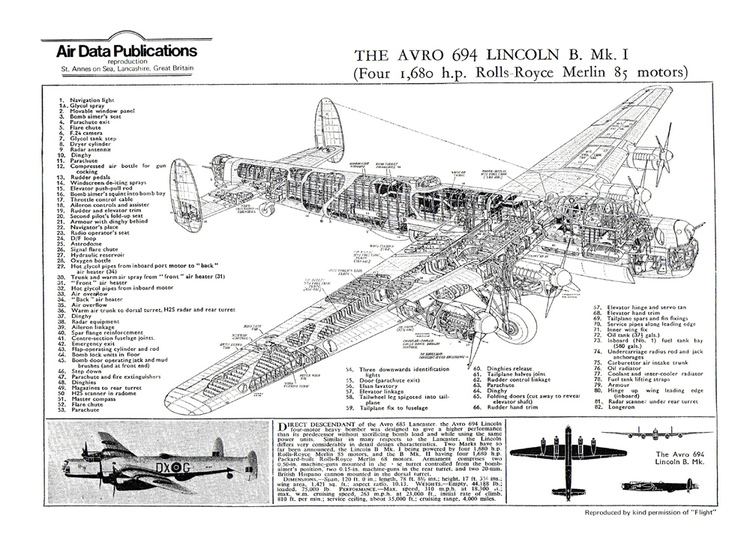
The Avro Lincoln was Roy Chadwick's development of the Lancaster, built to the Air Ministry Specification B.14/43, having stronger, longer span, higher aspect ratio (10.30 compared with 8.02) wings with two-stage supercharged Rolls-Royce Merlin 85 engines in Universal Power Plant (UPP) installations and with a bigger fuselage with increased fuel and bomb loads, allowing it to carry up to 4.5 tons of various armaments and equipment fittings. As a result of these changes, the Lincoln had a higher operational ceiling and longer range than the Lancaster, having a maximum altitude of 35,000 ft (6.5 miles) and a maximum range of 4450 miles.
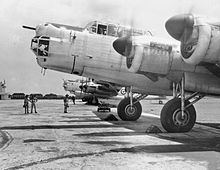
The prototype Lancaster IV (Lincoln I) was assembled by Avro's experimental flight department at Manchester's Ringway Airport and made its maiden flight from there on 9 June 1944. Production of the type was primarily performed at Avro's Woodford, Cheshire and Chadderton, Lancashire factories; additional aircraft were also constructed by Armstrong Whitworth at their Coventry facilities. Separate production lines were also set up in Canada and Australia, although with the end of the war, production in Canada (by Victory Aircraft) was halted after only one aircraft had been built. Production in Australia proceeded, the Lincolns that were subsequently manufactured there were operated by the Royal Australian Air Force (RAAF).
One Lincoln B Mk XV pattern aircraft was also completed in Canada by Victory Aircraft; a follow-up order for a total of six RCAF variants was cancelled shortly following the end of hostilities. Along with two additional (Mk I and Mk II) aircraft on loan from the RAF, the type was briefly evaluated postwar by the RCAF. The Lancaster V/Lincoln II differed mainly in that it was fitted with Merlin 68A engines.
Before the Lincoln was developed, the Australian government intended its Department of Aircraft Production (DAP), later known as the Government Aircraft Factory (GAF), would build the Lancaster Mk III. In its place, a variant of the Lincoln I, re-designated as Mk 30, was manufactured between 1946 and 1949; it has the distinction of being the largest aircraft ever built in Australia. Orders for a total of 85 Mk 30 Lincolns were placed by the RAAF (which designated the type A-73), although only 73 were ever produced.
The first five Australian examples (A73–1 to A73–5), were assembled using British-made components. On 17 March 1946, A73-1 conducted its début flight; the first entirely Australian-built Lincoln, A73-6, was formally delivered in November 1946. The Mk 30 initially featured four Merlin 85 engines, this arrangement was later changed to a combination of two outboard Merlin 66s and two inboard Merlin 85s. A further improved later version, designated as Lincoln Mk 30A, featured a total of four Merlin 102s.
During the 1950s, the RAAF heavily modified some of their Mk 30 aircraft to perform anti-submarine warfare missions, re-designating them GR.Mk 31. These examples had a 6 ft 6 in (1.98 m) longer nose to house acoustic submarine detection gear and its operators, larger fuel tanks to provide the aircraft with a 13-hour flight endurance and a modified bomb bay to accommodate torpedoes. The Mk 31 was particularly difficult to land at night, as the bomber used a tailwheel and the long nose obstructed the pilot's view of the runway. 18 aircraft were rebuilt to this standard in 1952, gaining new serial numbers. Ten were subsequently upgraded to MR.Mk 31 standard, which included an updated radar. These Lincolns served with No. 10 Squadron RAAF at RAAF Townsville; however, the discovery of corrosion in the wing spars led to the type's premature retirement in 1961.
The Avro Shackleton maritime patrol aircraft was derived from the Lincoln, as was the Tudor airliner, which used the wings of the Lincoln with a new pressurised fuselage.
Royal Air Force
The first RAF Lincolns joined No. 57 Squadron at East Kirby in 1945. No. 75 (New Zealand) Squadron RAF began re-equipping with Lincolns at RAF Spilsby during August 1945. However, 75 (NZ) Sqn received just three aircraft before VJ Day.
In the postwar Royal Air Force, the Lincoln equipped many bomber squadrons. Nearly 600 Lincolns were built to equip 29 RAF squadrons, mainly based in the United Kingdom. They were partially replaced by 88 Boeing Washingtons, on loan from the USAF, which had longer range and could reach targets inside the Iron Curtain. Small numbers remained in use with Nos 7, 83 and 97 Squadrons until the end of 1955, when they were replaced by the first of the V bombers.
RAF Lincolns were used in combat during the 1950s, in Kenya against the Mau-Mau, operating from Eastleigh, and also served in Malaya during the Malayan Emergency, against insurgents aligned to the Malayan Communist Party. In Malaya, Lincolns operated from Changi and Tengah, More than 3,000 sorties were flown during their 7 1⁄2-year deployment, with half a million pounds of bombs dropped. This equated to 85% of the bomb tonnage dropped during the Malayan emergency.
On 12 March 1953, a RAF Lincoln (RF531 "C") of Central Gunnery School was shot down 20 mi (32 km) NE of Lüneburg, Germany by several Soviet MiG-15s as it flew to Berlin on a radar reconnaissance flight, resulting in the deaths of the seven crew members.
In November 1955, four Lincolns of No. 7 Squadron RAF were detached for duties in British territories in the Middle East. In Bahrain, they carried out border patrols of the then Trucial States. When 7 Sqn was disbanded in December 1955, the four detached crews and aircraft became No. 1426 Flight RAF, officially a photographic reconnaissance unit. It was later sent to Aden, carrying out patrols in the lead up to the Aden Emergency.
As the RAF Lincolns became unserviceable due to wear and tear, they were replaced by jet aircraft. The Lincolns of Bomber Command were phased out from the mid-1950s and were completely replaced by jet bombers by 1963. The last Lincolns in RAF service were five operated by No. 151 Squadron, Signals Command, at RAF Watton, Norfolk, which were retired on 12 March 1963.
Royal Australian Air Force
From late 1946, Australian-built Lincolns were phased into No. 82 Wing RAAF at RAAF Amberley, replacing the Consolidated Liberators operated by 12, 21 and 23 Squadrons. In February 1948, these units were renumbered 1, 2 and 6 Squadrons respectively; a fourth RAAF Lincoln squadron, No. 10 was formed on 17 March 1949 at RAAF Townsville as a reconnaissance unit.
RAAF Lincolns took part in operations in Malaya in the 1950s, operating alongside RAF examples. The RAAF based the B.Mk 30s of No.1 Squadron at Tengah, for the duration of operations in Malaya.
The RAAF Lincolns were retired in 1961, with the MR.Mk 31s of No. 10 Squadron being the final variant to see service in Australia.
Argentine Air Force
The Lincoln served with the Fuerza Aerea Argentina from 1947: 30 aircraft were acquired (together with 15 Lancasters), giving Argentina the most powerful bombing force in South America. Eighteen of these were newly built, along with twelve ex-RAF aircraft. The Lincolns entered service with I Grupo de Bombardeo of V Brigada Aérea in 1947. Eleven remained in use at the beginning of 1965, but most were retired during the next year. The last examples were retired in 1967.
The Argentine aircraft were used in bombing missions against rebels, during the attempted military coup of September 1951 and by both the government and rebel forces during the 1955 Revolución Libertadora coup that deposed Juan Perón.
Lincolns were also used to drop supplies in support of Argentine operations in the Antarctic. One of the bombers was returned to Avro in 1948 for modification at Langar to allow it to operate Antarctic support flights, including the addition of Lancastrian nose and tail cones, additional fuel tanks, and removal of armament, becoming the first Avro Lincolnian. The aircraft was civilian registered and named Cruz del Sur; it undertook its first airdrop supply flight to the Antarctic San Martín Base in December 1951.
Use in aero-engine research
Lincolns were frequently employed as testbeds in new jet engine development. RF403, RE339/G and SX972 flew with a pair of Armstrong Siddeley Python turboprops outboard in place of the Merlins, and was used for the ballistic casing drop-test programme for the Blue Danube atomic weapon. SX972 was further modified to fly with a pair of Bristol Proteus turboprops. RA716/G had a similarly placed pair of Bristol Theseus turboprops and later also flew with Rolls-Royce Avon turbojets replacing the pair of turboprops. Lincoln Test Bed RF530 kept its Merlins but had a Napier Naiad turboprop in the nose. It later flew, bearing the civilian "Class B" test registration G-37-1, with a similarly placed Rolls-Royce Tyne which it displayed at the 1956 Society of British Aircraft Constructors (SBAC) show, making a low level flypast on just the nose Tyne, the four Merlins being shut down and propellers feathered.SX973 had a Napier Nomad diesel turbo-compound installed in a similar nose-mounted installation. RA643 flew with a Bristol Phoebus turbojet in the bomb bay, and SX971 had an afterburning Rolls-Royce Derwent mounted ventrally.
Commercial service
Two Lincoln IIs were operated by D. Napier & Son Ltd. for icing research from 1948 to 1962. A transport conversion of the Lincoln II, using the streamlined nose and tail cones of the Lancastrian and a ventral cargo pannier, was known as the Avro 695 Lincolnian.
One Lincoln Freighter converted by Airflight Ltd was used on the Berlin Air Lift by Surrey Flying Services Ltd.
Four Lincolnian conversions by Field Aircraft Services for use as meat haulers in Paraguay were not delivered and subsequently scrapped.
Variants
Operators
Argentina
Australia
United Kingdom
Specifications (Lincoln I)
Data from Aircraft of the Royal Air Force 1918–57
General characteristics
Performance
Armament
